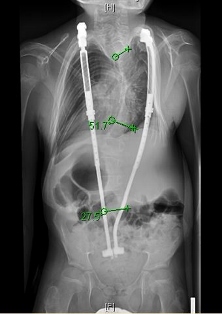|
Pediatric Medical Mystery at Orlando Health's Arnold Palmer Hospital Gets Published  Imagine being a doctor with a patient at risk of dying, but the one treatment available to help that patient makes him critically ill. Now imagine that patient is a 6-year old boy. That scenario played out at Arnold Palmer Hospital for Children at Orlando Health, and an incredibly dogged doctor found a way to save the child and challenge some established ideas in orthopedics. [An X-Ray showing the severity of Daniel Stephen's scoliosis and the placement of the titanium rods] “He basically saved my life,” says 14 year old Daniel Stephens. He’s talking about the man he calls his hero- Pediatric Orthopedic Surgeon Dr. Jonathan Phillips. Daniel has early onset scoliosis- that’s a progressive curvature of the spine that, if left untreated, would crush his lungs and kill him. The standard treatment is a set of surgically implanted titanium rods that slowly straighten his spine out. Dr. Phillips and Daniel’s parents, Dawn and Bill Stephens, pick up the story from here, beginning with Dr. Phillips. “The surgery went fine, we did well, initially, but then he started to get into all kinds of trouble, we couldn’t figure out what was going on initially, we thought this was just an infection, which unfortunately is a fairly common complication of early onset scoliosis, it turned out to be something more unusual and peculiar than that,” he says. “He had all this itching going on, he was running a fever, he had all these bizarre symptoms, so part of the scary was, what’s wrong with Daniel, you know?” says Bill Stephens. “And he continued to progress and get sick, he would have trouble breathing, he had nerve pain, he was on a different medication, he was taking medication every two hours 24 hours a day,” says Dawn Stephens. “And then one day he came into the clinic and it was like a lightbulb went off in my head, I said- he’s allergic to titanium, and this of course is an extremely rare problem, it’s been identified in the dental literature as an allergy to dental implants but I’d never seen it, never even heard of it in orthopedics, so this was something that was very weird,” says Phillips. “I remember Dr. Phillips consulting with other doctors, you know, asking, what is the possibility that he could be allergic to the equipment in his back? And they were like, oh no, that could never happen,” says Bill Stephens. A blood test confirmed Daniel was, in fact, allergic to titanium, along with any other metal that could be used in an implant. The rods in his back had to come out. “It was a rollercoaster for me because when we had to take the implants out because of this “quote” infection, which wasn’t actually, it was an allergy, his spine collapsed like a deck of cards and I knew that if we didn’t come up with a solution he was not going to make it and so this was an extremely frightening kind of thing to deal with as a surgeon because I just didn’t have a solution,” says Phillips. “His spine would not relent,” says Dawn Stephens, “it continued to progress and we were told, and we know, if we can’t stop the progression and the aggressiveness of his scoliosis, that he will asphyxiate and just not wake up one morning.” Daniel had to have the rods in his back replaced or he would die.The question was what to make them out of. Any material used needed the strength of titanium, and it needed to accommodate a sliding part- which ruled out any kind of rubber coating. Phillips consulted with doctors all over the world. He consulted with Nasa. He consulted with anyone he could think of. Then he thought about carbon coated sailboat masts. Could the titanium rods be coated with carbon? Yes, said engineers, they could plasma coat it. “So essentially what we did was camouflage the titanium from Daniel’s immune system, so we bamboozled it so it never knew that it was there,” says Phillips. That was seven years ago. Daniel, a kid who wasn’t expected to live, is now studying for his learners permit. Looking back, Daniel’s parents say Dr. Phillips’ independent thinking is what saved him. “It gave us hope for the next day of Daniel’s life, cause we’re never promised anything with him, as long as Dr. Phillips was working towards it, we had hope for prolonging his life expectancy, ” says Dawn Phillips. Daniel’s case has just been published in Spine Deformity – The Official Journal of the Scoliosis Research Society. Phillips says as far as he knows, this is the first documented case of its kind. Daniel requires surgery every four to six months to adjust his implants. The Stephens say their church has held numerous fundraisers throughout the years to help with Daniel’s medical costs. |
|
|